Tag: building-performance
September 1, 2020
Materials Matter
By Lara Pes We are all materialists. Whether we are choosing or using clothing or food containers, building blocks or paving, at every moment a wide range of materials are an integral part of our lives. Technology has allowed creation of sophisticated materials with specific characteristics, with improvements usually driven by a desire for practicality and lower costs. However, both synthetic and traditional materials have impacts on the environment and on human health that we need to be aware of and understand. These impacts can manifest at different stages of a product’s life cycle, either during raw material sourcing, the manufacturing stage, its use, or at the end of its life. We provide examples of each below, focusing on the built environment.
(more…)
We are all materialists. Whether we are choosing or using clothing or food containers, building blocks or paving, at every moment a wide range of materials are an integral part of our lives. Technology has allowed creation of sophisticated materials with specific characteristics, with improvements usually driven by a desire for practicality and lower costs. However, both synthetic and traditional materials have impacts on the environment and on human health that we need to be aware of and understand. These impacts can manifest at different stages of a product’s life cycle, either during raw material sourcing, the manufacturing stage, its use, or at the end of its life. We provide examples of each below, focusing on the built environment.
(more…)
March 3, 2019
Can NYC’s Energy Use Data Save The Earth?
By Warren Berger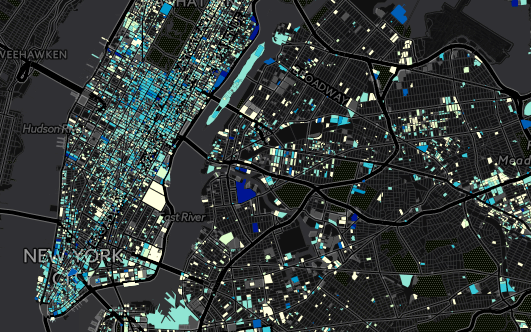 On Earth Day 2015, New York City Mayor Bill de Blasio announced One New York City: The Plan for a Strong and Just City (OneNYC). As part of the plan, Mayor de Blasio committed New York City to reduce carbon emissions by 80 percent by 2050 from 2005 levels (80 x 50), with an interim target to reduce emissions 40 percent by 2030 (40 x 30). But meeting those targets requires a good understanding of where the City’s emissions come from. New York City Buildings cause 75% of New York City’s carbon emissions. The residential sector accounts for 37 percent of the City’s total emissions, making it the largest single source of emissions in the City. Collecting energy use data in these buildings is certainly a good place to start, but will that be enough to meet the City’s aggressive goals and address the climate change challenge in time?
On Earth Day 2015, New York City Mayor Bill de Blasio announced One New York City: The Plan for a Strong and Just City (OneNYC). As part of the plan, Mayor de Blasio committed New York City to reduce carbon emissions by 80 percent by 2050 from 2005 levels (80 x 50), with an interim target to reduce emissions 40 percent by 2030 (40 x 30). But meeting those targets requires a good understanding of where the City’s emissions come from. New York City Buildings cause 75% of New York City’s carbon emissions. The residential sector accounts for 37 percent of the City’s total emissions, making it the largest single source of emissions in the City. Collecting energy use data in these buildings is certainly a good place to start, but will that be enough to meet the City’s aggressive goals and address the climate change challenge in time?
According to the New York State Energy and Research and Development Authority (NYSERDA) report, Realizing Measurable Savings in Multifamily Building: Results from NYSERDA’s Multifamily Performance Program:
“It is critical to the growth of the energy efficiency market that we improve the accuracy of savings predictions to decrease the risk involved with investing in efficiency. The first step in doing so is to track and analyze actual savings data to discover changes that practitioners or program administrators can make to improve the accuracy of savings predictions and to discover which factors cannot be changed so that building owners and investors better understand the inherent risks and the likelihood of project success.”
Local Laws Aim to Capture Energy Use Data New York City’s Local Law 84 of 2009 (LL84) requires annual benchmarking data to be submitted by owners of buildings with more than 50,000 square feet for public disclosure, creating transparency for energy and water usage and informing building owners and tenants on how to make their buildings more efficient. Local Law 133 of 2016 (LL133) expands the list of buildings required to benchmark to include mid-size buildings from 25,000 to 50,000 square feet. Local Law 87 of 2009 (LL87) requires covered buildings spanning 50,000 square feet or more to audit their energy consumption and conduct retro-commissioning of building systems, including the building envelope, boiler, domestic hot water, ventilation and lighting. Compliance is Complex What has the data collection process taught us about what it takes to motivate action and effect change in the city’s residential buildings? For one thing, it’s clear from benchmarking extensions that gaining compliance isn’t a simple matter. Early last year, the City announced a deadline extension for submission of 2017 benchmarking reports for mid-sized buildings to December 31, 2018. In September 2018, the deadline was extended again, this time to February 1, 2019. In 2018, the New York City Department of Buildings and the NYC Benchmarking Help Center publicized three walk-in help sessions, which took place in May, October and November, for building owners who want more information about compliance. The center also maintains a telephone and e-mail service for owners who want more information, assistance, and answers to questions about the NYC Benchmarking Law. (more…)May 29, 2018
March Forum Recap: Sustainable Policy 201
by Miaoru Guan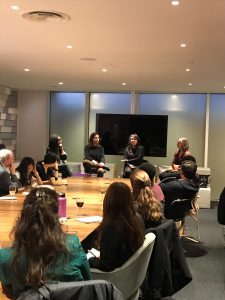 The Sustainable Policy 201 Forum featured four speakers working towards sustainable, affordable housing through diverse but connected roles. Michelle Andry works at New York State Energy Research and Development Authority (NYSERDA), where she focuses on energy efficiency, clean energy, and energy affordability initiatives impacting low-income housing. Francesca Camillo, Project Manager at NYC Department of Housing Preservation and Development (HPD), assists building owners in procuring funding for rehabilitation. Elizabeth Kelly, Manager of Sustainability Programs at The Community Preservation Corporation (CPC), leverages private capital to support sustainable multi-family housing and community revitalization projects. Andrea Mancino is Director of New Construction at Bright Power, and manages team members working on ground-up new construction and commissioning projects.
The panelists discussed how effective policy can encourage wider adoption of sustainable practices in housing by facilitating financing from government sources. For example, to qualify for government funding, new construction and rehabilitation buildings must receive building certification, such as Enterprise Green Communities or LEED certification. Mancino mentioned that achieving certification as an Enterprise Green Community requires buildings to outperform standard building code by 15%. Kelly discussed how these standards help the CPC and private lenders ensure projects have fulfilled a sustainability checklist, reducing the time projects spend in due diligence. Andry added that certified buildings are eligible for NYSERDA grants as well as HPD funding.
(more…)
The Sustainable Policy 201 Forum featured four speakers working towards sustainable, affordable housing through diverse but connected roles. Michelle Andry works at New York State Energy Research and Development Authority (NYSERDA), where she focuses on energy efficiency, clean energy, and energy affordability initiatives impacting low-income housing. Francesca Camillo, Project Manager at NYC Department of Housing Preservation and Development (HPD), assists building owners in procuring funding for rehabilitation. Elizabeth Kelly, Manager of Sustainability Programs at The Community Preservation Corporation (CPC), leverages private capital to support sustainable multi-family housing and community revitalization projects. Andrea Mancino is Director of New Construction at Bright Power, and manages team members working on ground-up new construction and commissioning projects.
The panelists discussed how effective policy can encourage wider adoption of sustainable practices in housing by facilitating financing from government sources. For example, to qualify for government funding, new construction and rehabilitation buildings must receive building certification, such as Enterprise Green Communities or LEED certification. Mancino mentioned that achieving certification as an Enterprise Green Community requires buildings to outperform standard building code by 15%. Kelly discussed how these standards help the CPC and private lenders ensure projects have fulfilled a sustainability checklist, reducing the time projects spend in due diligence. Andry added that certified buildings are eligible for NYSERDA grants as well as HPD funding.
(more…)
December 4, 2017
GreenHomeNYC Year in Review: Taking on the Environmental Challenge
by Pamela Berns It’s been a year marked by extreme weather events, with hurricanes, fires, droughts, and flooding all across the globe. In the United States we saw Houston drown and Santa Rosa burn just a few months after Trump’s pullout from the Paris agreement in June. Climate advocacy groups, local policy makers, corporations, entrepreneurs, individuals, and nonprofits all stepped up their game in defense of the planet, and GreenHomeNYC was no exception. Thanks to the dedication of our volunteers, we were able to deepen our commitment to providing education and calls to action. Our speakers and our blog writers shared critical information on local policy, business actions, and academic initiatives. Record numbers of event attendees turned up to hear from innovators in energy, food waste, recycling, and sustainable building. Green careerists came out to find out where to point their compasses in the new paradigm. We’re proud of the hard work that went into this challenging year, and hope that our contributions made a difference. Here are just a few GreenHomeNYC highlights for 2017: (more…)December 3, 2017
NYC’s 80 x 50 Goal: Is it Realistic? How Do We Get There?
By: Tom SahagianNovember 28, 2017
November Green Building Tour Recap: Building Towards Resilience
by Brigitta Berze It’s been five years since Hurricane Sandy hit the East Coast, leaving a trail of destruction in the New York area. During the “Building Towards Resilience” Green Building Tours event, Henry Gifford of Chris Benedict R.A., led a tour through 327 and 334 East 8th Street – two Lower East Side buildings that were affected by the hurricane – providing a firsthand look at renovations that were made in the aftermath of the natural disaster.
It’s been five years since Hurricane Sandy hit the East Coast, leaving a trail of destruction in the New York area. During the “Building Towards Resilience” Green Building Tours event, Henry Gifford of Chris Benedict R.A., led a tour through 327 and 334 East 8th Street – two Lower East Side buildings that were affected by the hurricane – providing a firsthand look at renovations that were made in the aftermath of the natural disaster.
The tour began in the noisy basement of 334 East 8th Street, with a description of the damage after Hurricane Sandy, including the conditions that the workers had to endure. The elevator in this building is not counteracted by weights to lift the elevator car, but instead uses oil mixed with other chemicals in a hydraulic elevator machine. As the water rose to about six feet above the basement floor, the oil and chemicals mixed with the flood waters, creating a hazardous condition for workers. The slippery mix of oil, water and sewage caused the superintendant to get a foot infection that landed him in the hospital for three days.
(more…)September Forum Recap: Spotlight on Hudson Yards
by Jennifer Urrutia
Photo source: ny.curbed.com
November 27, 2017
October Forum Recap: Women of Green
by Claire Brown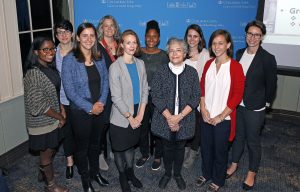 During GreenHomeNYC’s October Forum, eight women of green led us on a tour of their green building career paths. Through the Pecha Kucha style of presentation, the speakers used timed-slides to guide us through their search for their dream careers in engineering, sustainable design, new construction, and more. In addition to sharing their stories, the speakers offered advice to those seeking green careers. The forum was co-hosted by GreenHomeNYC and the Center on Global Energy Policy’s Women in Energy program at Columbia University.
During GreenHomeNYC’s October Forum, eight women of green led us on a tour of their green building career paths. Through the Pecha Kucha style of presentation, the speakers used timed-slides to guide us through their search for their dream careers in engineering, sustainable design, new construction, and more. In addition to sharing their stories, the speakers offered advice to those seeking green careers. The forum was co-hosted by GreenHomeNYC and the Center on Global Energy Policy’s Women in Energy program at Columbia University.
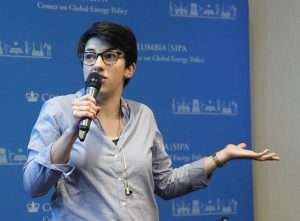 Lucie Dupas, Entersolar
Dupas had engineering built into her genetic blueprint, with both of her parents working as IT engineers. She finished her formal education in engineering by completing a Master’s program in France, and was proud that the program was comprised of roughly 42% women. Surrounded by so many women in her field, she felt that being a female engineer was “the normal thing to do.” In search of her dream internship, Dupas moved to New York City and joined a renewable energy consulting startup at the NYU Poly Acre Incubator where she built her first photovoltaic system. The internship ultimately led to a full-time job at Sollega, a solar equipment manufacturer where she did “all the things that you think an engineer does”. According to Dupas, “I did a 3-D design of a racking part and tested it in a laboratory and I trained some 200 pound electricians.” Next she worked at Bright Power, where she helped bring solar power to affordable housing and managed the installation of several solar thermal and photovoltaic systems. She is now the Engineering Director at the nationwide solar installer Entersolar where she works on commercial projects with a specific focus on solar PV technology. Lucie is an avid proponent of training programs. “You know how you think you know something, but then you go through a certification program and you realize there’s so much that you don’t really know. And having the certification on your resume is so useful to show yourself as an expert in the industry.”
(more…)
Lucie Dupas, Entersolar
Dupas had engineering built into her genetic blueprint, with both of her parents working as IT engineers. She finished her formal education in engineering by completing a Master’s program in France, and was proud that the program was comprised of roughly 42% women. Surrounded by so many women in her field, she felt that being a female engineer was “the normal thing to do.” In search of her dream internship, Dupas moved to New York City and joined a renewable energy consulting startup at the NYU Poly Acre Incubator where she built her first photovoltaic system. The internship ultimately led to a full-time job at Sollega, a solar equipment manufacturer where she did “all the things that you think an engineer does”. According to Dupas, “I did a 3-D design of a racking part and tested it in a laboratory and I trained some 200 pound electricians.” Next she worked at Bright Power, where she helped bring solar power to affordable housing and managed the installation of several solar thermal and photovoltaic systems. She is now the Engineering Director at the nationwide solar installer Entersolar where she works on commercial projects with a specific focus on solar PV technology. Lucie is an avid proponent of training programs. “You know how you think you know something, but then you go through a certification program and you realize there’s so much that you don’t really know. And having the certification on your resume is so useful to show yourself as an expert in the industry.”
(more…)
June 5, 2017
June Tour: 475 High Performance Building Supply House and Demo
GreenHomeNYC INVITES YOU TO
DISCOVER HIGH PERFORMANCE BUILDING MATERIALS IN BROOKLYN
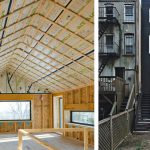 Join us to learn how leading architects and developers achieve rigorous Passive House standards here in the City. We will tour the 475 High Performance Building Supply warehouse in Brooklyn to learn about the latest products that can lead to 90% reductions in heating and cooling energy usage. Founded and run by architects, 475 provides building knowledge and components to help professionals meet the international Passive House building standards. Guests will be treated to an interactive presentation on green building materials and diagnostic testing that improve air sealing, ventilation, fenestration, thermal insulation, and overall performance. This is a hands-on experience with cutting edge green building materials. It’s the next best thing to being in the Paris Agreement!
Join us to learn how leading architects and developers achieve rigorous Passive House standards here in the City. We will tour the 475 High Performance Building Supply warehouse in Brooklyn to learn about the latest products that can lead to 90% reductions in heating and cooling energy usage. Founded and run by architects, 475 provides building knowledge and components to help professionals meet the international Passive House building standards. Guests will be treated to an interactive presentation on green building materials and diagnostic testing that improve air sealing, ventilation, fenestration, thermal insulation, and overall performance. This is a hands-on experience with cutting edge green building materials. It’s the next best thing to being in the Paris Agreement!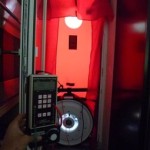 After the tour guests are encouraged to join GreenHomeNYC for networking drinks at nearby Threes Brewing
After the tour guests are encouraged to join GreenHomeNYC for networking drinks at nearby Threes Brewing
April 28, 2017
Living Building Challenge: Designing for an Equitable and Regenerative Future
by Sunitha Sarveswaran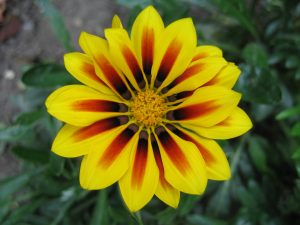 Have you ever considered how a flower functions? It lives off the resources available to it, using the sun, water and soil in its immediate surroundings to thrive. It also provides a service to its surrounding environment, in the way of food, shelter and aesthetic beauty. This is what a building following the Living Building Challenge® certification is designed to emulate.
Living Building Challenge (LBC) was created by the Cascadia Green Building Council in 2006. It was born from the concept that a building should not only be energy efficient, but also have a positive impact on its residents and the community. Buildings that take on the Challenge go above and beyond typical high performance buildings. The aim of LBC is to reduce the energy and water footprint of a building down to the amount it can produce on site. In addition, LBC asks buildings to connect residents and communities with healthy, beautiful and renewing environments. These are very tall orders!
(more…)
Have you ever considered how a flower functions? It lives off the resources available to it, using the sun, water and soil in its immediate surroundings to thrive. It also provides a service to its surrounding environment, in the way of food, shelter and aesthetic beauty. This is what a building following the Living Building Challenge® certification is designed to emulate.
Living Building Challenge (LBC) was created by the Cascadia Green Building Council in 2006. It was born from the concept that a building should not only be energy efficient, but also have a positive impact on its residents and the community. Buildings that take on the Challenge go above and beyond typical high performance buildings. The aim of LBC is to reduce the energy and water footprint of a building down to the amount it can produce on site. In addition, LBC asks buildings to connect residents and communities with healthy, beautiful and renewing environments. These are very tall orders!
(more…)

